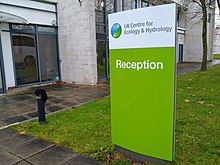UK Centre for Ecology & Hydrology
 | |
 | |
| Abbreviation | UKCEH |
|---|---|
| Formation | 1994[1] |
| Legal status | Not-for-profit company limited by guarantee with charitable status |
| Purpose | Environmental science for a world where people and nature prosper |
| Headquarters | Wallingford, Oxfordshire, U.K. |
Region served | United Kingdom |
Executive Director | Professor Mark Bailey |
| Website | www |
The UK Centre for Ecology & Hydrology (UKCEH) is a centre for excellence in environmental science across water, land and air. The organisation has a long history of investigating, monitoring and modelling environmental change, and its science makes a difference in the world. The issues that its science addresses include: air pollution, biodiversity, chemical risks in the environment, extreme weather events, droughts, floods, greenhouse gas emissions, soil health, sustainable agriculture, sustainable ecosystems, water quality, and water resources management.
UKCEH is a strategic delivery partner for the Natural Environment Research Council (NERC), part of UK Research and Innovation (UKRI). The institute has four locations: Wallingford (its headquarters), Edinburgh, Lancaster and Bangor.
UKCEH is a member of the Partnership for European Environmental Research (PEER).[2]
History
The Centre for Ecology & Hydrology (CEH) was formally established in March 1994 by Professor John Krebs (now Lord Krebs) the then Chief Executive of NERC. It was formed by the drawing together of four research institutes: the Institute of Hydrology, the Institute of Terrestrial Ecology, the Institute of Freshwater Ecology and the Institute of Virology and Environmental Microbiology.[1]
Professor Brian Wilkinson was appointed as the first CEH Director in 1994. He had previously been Director of the Institute of Hydrology and prior to then a Professor of Civil Engineering at Cranfield University. In 1994 CEH had 15 laboratories and field stations across the UK. From 1996 onwards the number of sites was reduced and the Centre now operates from 4 locations across the UK.
In the early years there was a need to integrate environmental science across the institutes: joint science programs were established together with an inter-disciplinary science fund. CEH expanded over the next few years & by 1999 there were some 600 staff and about 300 students linked to the universities, with most registered for post-graduate qualification. CEH had global outreach with around 60 worldwide research projects.[1] A new CEH headquarters was constructed on the Wallingford site.
On the retirement of Professor Wilkinson in 1999 Professor Mike Roberts was appointed as CEH Director. Professor Roberts was succeeded by Professor Nuttall in 2001.
Following UK Government approval in 2019, the Centre for Ecology & Hydrology became autonomous from UK Research and Innovation (UKRI) and the Natural Environment Research Council (NERC), launching as a not-for-profit company limited by guarantee with charitable status on December 1 that year. At the same time, it also changed its name to the UK Centre for Ecology & Hydrology (UKCEH). The current Executive Director of UKCEH is Professor Mark Bailey, who was appointed to the position on a permanent basis in 2012.
Notable people
- Lord John Krebs, chief executive of NERC in 1994
- Brian Wilkinson, director between 1994 and 1999
- Mike Roberts, director between 1999 and 2001
- Pat Nuttall, director between 2001 and 2011
- Mark J. Bailey, current Executive Director[3]
- Lord (Ewen) Cameron, Chair of the Board of Trustees
- Helen Roy, Principal Scientist-Ecologist
- Mark O. Hill, Mathematical ecologist known for developing Hill numbers, a type of diversity index used in ecology, as well as detrended correspondence analysis and two-way indicator species analysis
See also
- OpenMI Standard · UKCEH is the lead organisation for the Open Modelling Interface standard.
References
- ^ a b c "CEH Annual Report 1994-95" (Report). 1995. ISBN 1 85531 1526.
- ^ "Centre for Ecology & Hydrology". www.peer.eu. 19 March 2014. Archived from the original on 9 May 2016. Retrieved 26 April 2016.
- ^ "Professor Mark Bailey becomes acting Director of the Centre for Ecology & Hydrology", Centre for Ecology & Hydrology website, Natural Environment Research Council, 1 March 2011, archived from the original on 23 July 2014, retrieved 16 March 2015
